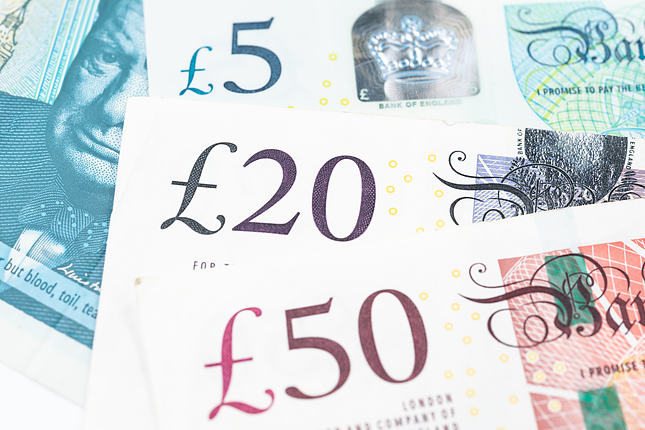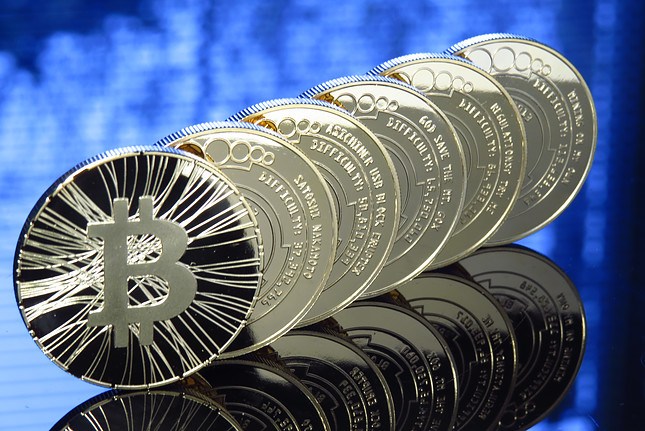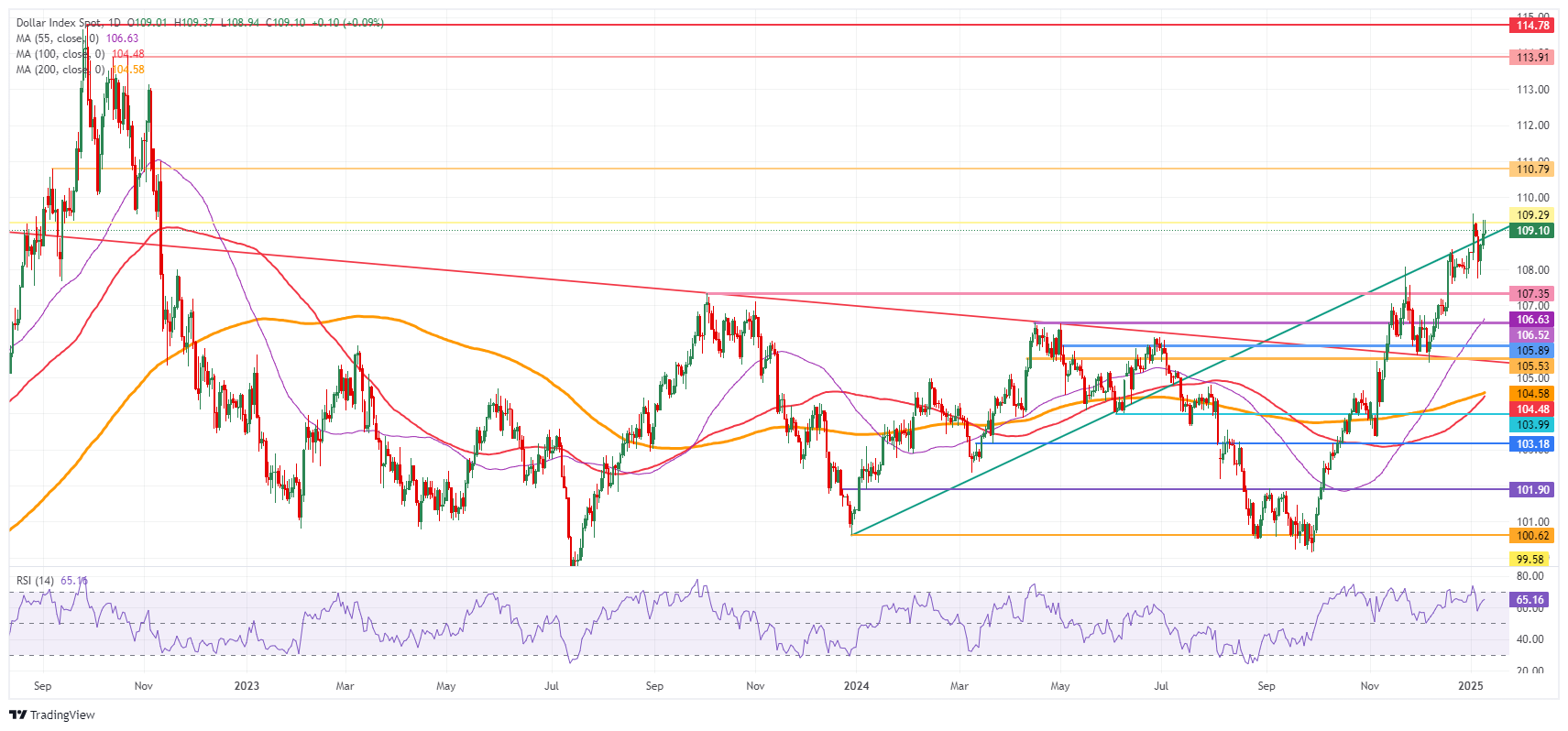- The US Dollar remains stuck at current levels around 109.00.
- Inflation concerns remain top priority this week, triggering a mini-crisis in UK Gilts earlier this Thursday.
- The US Dollar Index (DXY) hovers arond 109.00 in search of support.
The US Dollar Index (DXY), which tracks the Greenback’s value against six major currencies, trades muted near 109.00 on Thursday while bond markets are easing down after an already volatile week. Yields surged across the globe after traders started to worry about all the plans President-elect Donald Trump wants to implement, e most of them perceived as highly inflationary. This has triggered widening rate differentials between the US and other countries
The mentioned surges in yields triggered a brief mini-crisis in UK Gilts. This week, long-term UK borrowing costs have soared substantially and the British Pound (GBP) has fallen. Markets perceive this as a sign that investors have lost faith in the government’s ability to manage the national debt and control inflation, while the British government is soothing by communicating it will stick to its fiscal rules even if borrowing costs will hit their higest level since the financial crisis, the FT reports.
The US economic calendar is light, with a shortened trading day due to the National Day of Mourning for former President Jimmy Carter. The US Challenger Job Cuts number for December will get most of the attention, while four Fed members are set to speak.
Daily digest market movers: Taking a step back
- US stock markets will remain closed or will be trading in shortened hours this Thursday in honor of former President Jimmy Carter.
- December Challenger Job Cuts came in at 38,792, softer than the previous 57,727.
- The Fed Minutes released on Wednesday showed Fed officials confirming a gradual and possibly longer steady rate before considering to cut further, Bloomberg reported.
- At 14:00 GMT, Federal Reserve Bank of Philadelphia President Patrick Harker speaks in Princeton right before the National Association of Corporate Directors New Jersey Chapter Economic Forecast 2025.
- Around 17:40 GMT, the Federal Reserve Bank of Richmond Thomas Barkin speaks to the Virginia Bankers Association and the Virginia Chamber of Commerce.
- At 18:30 GMT, the Federal Reserve Bank of Kansas City President Jeffrey Schmid delivers a speech on the economic and monetary policy outlook at the Economic Club of Kansas City.
- Around 18:35GMT, the Federal Reserve Governor Michelle Bowman will give a speech at the California Bankers Association 2025 Bank Presidents Seminar about 2024 reflections, including monetary policy, economic performance and lessons for banking regulation.
- Equities are griding to a halt in the US with US futures trading halted for the funeral of former US President Jimmy Carter.
- The CME FedWatch Tool is projecting a 93.1% chance that interest rates will be kept unchanged at current levels in the January meeting. Further on, expectations are for the Fed to remain data-dependent with uncertainties that could influence the inflation path once President-elect Donald Trump takes office on January 20.
- US yields are softening a touch with the US 10-year benchmark at 4.66%, off the fresh nine -month high at 4.728% seen on Wednesday.
US Dollar Index Technical Analysis: Looking for clues
The US Dollar Index (DXY) seems to be stalling its rally just above 109.30 on Thursday. Although 110.00 is very near, the DXY might need to dip again back to 108.00 or lower in order to take out that 110.00 level in the next rally, as the market seems to have fully priced in all inflation elements for now.
On the upside, it is key that the green ascending trend line can hold as support, although that is often not the scenario going forward. If the DXY can head and break above the 110.00 psychological barrier, 110.79 becomes the next big level. Once beyond there, it is quite a stretch to 113.91, the double top from November 2023.
On the contrary, the first downside barrier is 107.35, which has now turned into support. The next level that might halt any selling pressure is 106.52, with the 55-day Simple Moving Average (SMA) at 106.63 reinforcing this region of support.
US Dollar Index: Daily Chart
Central banks FAQs
Central Banks have a key mandate which is making sure that there is price stability in a country or region. Economies are constantly facing inflation or deflation when prices for certain goods and services are fluctuating. Constant rising prices for the same goods means inflation, constant lowered prices for the same goods means deflation. It is the task of the central bank to keep the demand in line by tweaking its policy rate. For the biggest central banks like the US Federal Reserve (Fed), the European Central Bank (ECB) or the Bank of England (BoE), the mandate is to keep inflation close to 2%.
A central bank has one important tool at its disposal to get inflation higher or lower, and that is by tweaking its benchmark policy rate, commonly known as interest rate. On pre-communicated moments, the central bank will issue a statement with its policy rate and provide additional reasoning on why it is either remaining or changing (cutting or hiking) it. Local banks will adjust their savings and lending rates accordingly, which in turn will make it either harder or easier for people to earn on their savings or for companies to take out loans and make investments in their businesses. When the central bank hikes interest rates substantially, this is called monetary tightening. When it is cutting its benchmark rate, it is called monetary easing.
A central bank is often politically independent. Members of the central bank policy board are passing through a series of panels and hearings before being appointed to a policy board seat. Each member in that board often has a certain conviction on how the central bank should control inflation and the subsequent monetary policy. Members that want a very loose monetary policy, with low rates and cheap lending, to boost the economy substantially while being content to see inflation slightly above 2%, are called ‘doves’. Members that rather want to see higher rates to reward savings and want to keep a lit on inflation at all time are called ‘hawks’ and will not rest until inflation is at or just below 2%.
Normally, there is a chairman or president who leads each meeting, needs to create a consensus between the hawks or doves and has his or her final say when it would come down to a vote split to avoid a 50-50 tie on whether the current policy should be adjusted. The chairman will deliver speeches which often can be followed live, where the current monetary stance and outlook is being communicated. A central bank will try to push forward its monetary policy without triggering violent swings in rates, equities, or its currency. All members of the central bank will channel their stance toward the markets in advance of a policy meeting event. A few days before a policy meeting takes place until the new policy has been communicated, members are forbidden to talk publicly. This is called the blackout period.
Information on these pages contains forward-looking statements that involve risks and uncertainties. Markets and instruments profiled on this page are for informational purposes only and should not in any way come across as a recommendation to buy or sell in these assets. You should do your own thorough research before making any investment decisions. FXStreet does not in any way guarantee that this information is free from mistakes, errors, or material misstatements. It also does not guarantee that this information is of a timely nature. Investing in Open Markets involves a great deal of risk, including the loss of all or a portion of your investment, as well as emotional distress. All risks, losses and costs associated with investing, including total loss of principal, are your responsibility. The views and opinions expressed in this article are those of the authors and do not necessarily reflect the official policy or position of FXStreet nor its advertisers. The author will not be held responsible for information that is found at the end of links posted on this page.
If not otherwise explicitly mentioned in the body of the article, at the time of writing, the author has no position in any stock mentioned in this article and no business relationship with any company mentioned. The author has not received compensation for writing this article, other than from FXStreet.
FXStreet and the author do not provide personalized recommendations. The author makes no representations as to the accuracy, completeness, or suitability of this information. FXStreet and the author will not be liable for any errors, omissions or any losses, injuries or damages arising from this information and its display or use. Errors and omissions excepted.
The author and FXStreet are not registered investment advisors and nothing in this article is intended to be investment advice.
Recommended content
Editors’ Picks

EUR/USD holds around 1.0300, with USD still dominating the scene
EUR/USD trades within familiar levels at around the 1.0300 mark, although the US Dollar pushes marginally higher in a quiet, holiday-inspired American session. Focus shifts to US Nonfarm Payrolls on Friday.

GBP/USD rebounds from multi-month lows, trades around 1.2300
GBP/USD trimmed part of its early losses and trades around 1.2300 after setting a 14-month-low below 1.2250. The pair recovers as the UK gilt yields correct lower after surging to multi-year highs on a two-day gilt selloff. Markets keep an eye on comments from central bank officials.

Gold hovers around $2.670, aims higher
Gold extended its weekly recovery and traded at its highest level since mid-December, above $2,670. The bright metal retreated modestly in a quiet American session, with US markets closed amid a National Day of Mourning.

Bitcoin falls below $94,000 as over $568 million outflows from ETFs
Bitcoin continues to edge down, trading below the $94,000 level on Thursday after falling more than 5% this week. Bitcoin US spot Exchange Traded Funds recorded an outflow of over $568 million on Wednesday, showing signs of decreasing demand.

How to trade NFP, one of the most volatile events Premium
NFP is the acronym for Nonfarm Payrolls, arguably the most important economic data release in the world. The indicator, which provides a comprehensive snapshot of the health of the US labor market, is typically published on the first Friday of each month.

Best Forex Brokers with Low Spreads
VERIFIED Low spreads are crucial for reducing trading costs. Explore top Forex brokers offering competitive spreads and high leverage. Compare options for EUR/USD, GBP/USD, USD/JPY, and Gold.
